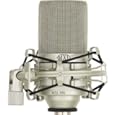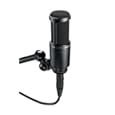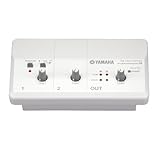Apr 16, 06:46 PM
How to Record Clear Audio
Tired of computer fan-noises, clicking, buzzing, drop-outs, hissing in your recordings? You can get clear good-sounding audio without needing a full recording studio.
First some DON’Ts:
- Don’t use the internal microphone on laptops. They are poor quality and way too close to the computer fan and hard drive.
- Don’t use the “mic in” jack on your computer. It goes to a low quality hissy pre-amplifier that muddles your sound.
- Don’t use those skinny pencil-shaped “computer microphones” whether they connect via USB or 1/8” plug. They’re fine for voice chatting, but are too shoddy for music and good voice recordings.
Here are the key things to do, to get clear recordings:
1) Get a real microphone
By “real”, I mean the kind with a 3-pin XLR connector. You’ll need an XLR cable as well to hook up the mic. The advantages of XLR is that the mic cable is immune to electrical interference and can send pristine signals over long cable lengths. So you get better cleaner sound.
There are two main types of microphones: condenser and dynamic.
Condensers are more sensitive and clearer, but also pick up more background room sounds, and they sound more open and transparent.
Dynamics are more rugged and tend to stay focused on the sounds closest to them, but sound a little more stuffy and up close. They are also more picky about what audio interface you use (mentioned below) because they require more amplification/gain.
I recommend dynamics only if background room noises including boxy sounding echoes off the walls are a problem, or if you need the sound of a dynamic like the SM57 for guitar amp recording. Look into Sennheiser, Audio Technica, and Shure for dynamics. Avoid any ones under $50 … generally the ones from $75 – $120 are excellent while $120-$250 are luxury.
Condensers truly are better. A cheap condenser will have a wider frequency range than an expensive dynamic. They sound more pristine, and are best for vocals, acoustic guitar, and piano. Look up ratings and reviews before you buy.
Some condenser recommendations:

MXL 990 condenser – only $50. A bit on the trebly/tinny side, which can be fixed through EQ.

Audio Technica AT2020 – next step up for $75. I’ve had great results with this one.

Studio Projects B1 – next step up for $115.

Studio Projects C1 – Next step up for $250.
2) Get a USB audio interface
This is the key. These boxes connect via USB to you computer, and let you plug in your dynamic or condenser mic. Unlike typical computer sound-cards, they have better amplifier circuitry and inputs.
Some recommendations:

Tascam US-100 – If you’re on a budget. $75, single channel. Gain: 60dB.

Art USB Audio Interface – Pretty good for $99. Single Channel. Gain: 48dB.

Yamaha Audiogram 3 – Very good, $119, single channel. Gain: 44 dB.

Presonus AudioBox – Dual channel, $145. Gain: 35dB (not high enough for dynamics). Excellent for condensers.
Tips
The quality of the sound going into the microphone is what matters most. This is determined by:
1) The sound source itself. Good or bad voice, powerful or tinny guitar amp, articulate or muddy guitar pickups.
2) The microphone positioning relative to sound source and the room. Adjust it until it sounds right. Keep it away from walls. Too close to the sound source and it gets boomy. Too far away and it gets tinny.
3) The room itself. Small echoey rooms are horrible, as are closets. Best to record in your largest room with clothes, furniture, bookshelves, anything to absorb sound.
4) Background room noises. The computer fan and hard drive clicking, outside traffic, neighbors yelling, aliens tapping on your window, etc… Record as far away from the computer as possible, or put the computer in a closet (make sure it has room to breathe, otherwise it will overheat).
If you simply cannot record in a quiet place, then avoid condensers and go with a dynamic microphone with a cardioid or hyper-cardioid sound pattern, and make sure your audio interface has up to -45 dB gain to drive it. If you need a recommendation, then I say go with the Shure SM58, or if money’s tight then an SM48 for half the cost of the 58.
The above mic and interface recommendations are for budget recording. It’s the minimum needed to get good clear sound, provided the audio going into the mic is good. You can use software compressors, de-essers, EQ, and plate reverb to make up for any of their shortcomings. It’s better to record dry (free of echoes, natural room reverb) and add effects afterwards.
Anything cheaper than these recommendations will have muddiness, unacceptable hissing, and so on. Anything more expensive and you’re paying more for extra reliability, extra features, and audiophile type marginal improvements. Do it if you have the cash, but please understand that more accurate recording of an audio signal doesn’t make up for a bad signal to begin with.
If you can’t get good clear sound with the above budget items, then the problem lies elsewhere and throwing more money into luxury interfaces and thousand dollar mics would be a waste. Then I would recommend improving what’s going into the mics. Sound engineering is where it’s at.
So, with $150-$300 for an interface and mic (and stand and cable) you can get 80%-90% the quality of pro-level recordings. To the average person they will sound indistinguishable. I know because I have done it, using just a Presonus Audiobox interface and AT2020 condenser — the rest being done through sound engineering and post-processing.